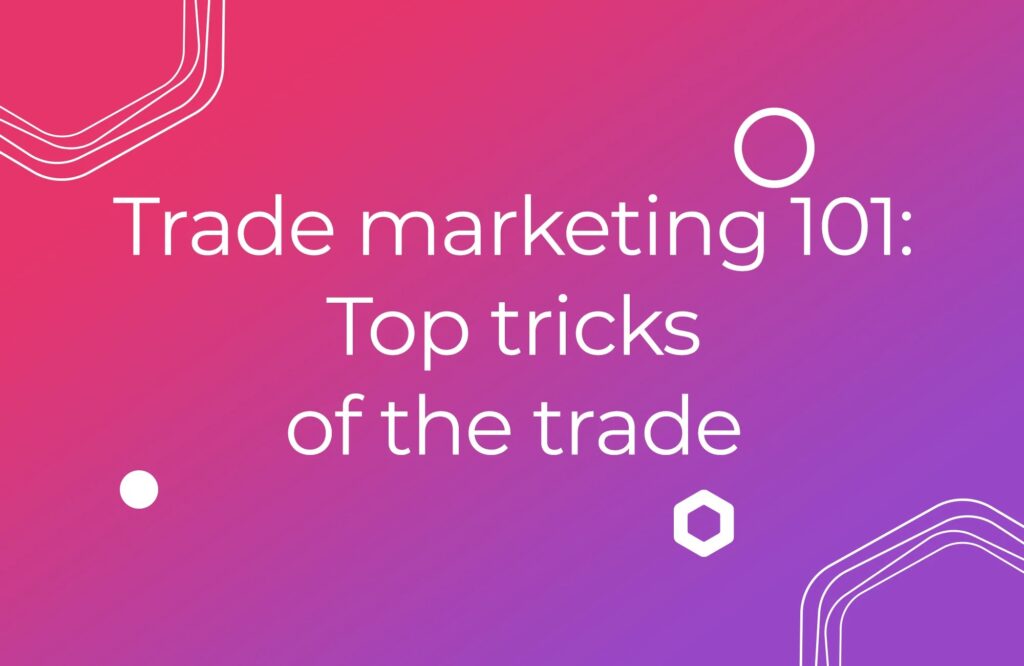


Great trade marketing is the backbone of sales success for any business that promotes products and services through third parties such as wholesalers, dealers, retailers and distributors.
By harnessing the very best trade marketing tactics, businesses like these can not only boost sales but also strengthen their position in the market, enhance brand visibility and build a fiercely loyal B2B client base.
This blog provides insights and actionable advice for businesses looking to refine their trade marketing strategies. So let’s dive in.
Skip to:
What is the definition of trade marketing?
Trade marketing (or B2B marketing) is about fostering mutually beneficial relationships between manufacturers and the business partners responsible for distributing their products to customers. It is a strategic approach businesses take to sell their products or services to retailers, wholesalers or distributors instead of directly to consumers.
Essentially, this revolves around meeting the needs and preferences of intermediaries in the supply chain. Using various promotional tactics and support mechanisms to encourage retailers and wholesalers to prioritise and effectively promote particular products to end consumers.
A key objective of trade marketing is to ensure that products are readily available and prominently displayed in retail outlets, increasing their visibility to potential buyers. This may entail negotiating favourable shelf space, designing attractive point-of-sale displays or offering promotional discounts to incentivise bulk purchases.
Another crucial aspect of trade marketing is establishing strong partnerships and collaborations with key stakeholders in the distribution network. By fostering positive relationships with retailers, wholesalers and distributors, businesses can gain valuable insights into market trends, consumer preferences and competitor activities. This enables them to adapt their marketing strategies accordingly and stay ahead in the competitive landscape.

What does someone in trade marketing do?
The role of Trade Marketing Managers, Execs and Directors typically involves bridging the gap between the manufacturer and the end consumer. They achieve this through strategies that enhance product visibility, availability and appeal within the distribution network.
Here’s a breakdown of what their day-to-day role might entail:
- Market analysis: Trade marketers conduct thorough market research to understand consumer preferences, market trends and competitor activities. This helps to differentiate products and gain a competitive edge.
- Developing marketing plans: Referring to market analysis, trade marketers formulate comprehensive marketing plans tailored to the needs of different distribution channels. These plans include promotional activities, pricing strategies and distribution tactics aimed at maximising product exposure (and sales of course).
- Negotiating with retailers: Trade marketers negotiate agreements to secure prime shelf space, prominent product placement and favourable terms for promoting products. Therefore, this involves building strong relationships with key stakeholders and effectively communicating the value proposition of the products.
- Creating promotional materials: Trade marketers collaborate with creative teams to develop promotional materials such as point-of-sale displays and advertising materials, specifically designed to attract consumer attention and drive sales at retail locations.
- Training and support: Trade marketers provide training and support to retailers and sales teams to ensure they have a thorough understanding of the products being promoted. This may involve product demonstrations, sales training sessions and providing marketing collateral to aid in selling efforts.
- Adapting strategies: Trade marketers continuously monitor market dynamics and consumer behaviour to adapt marketing strategies accordingly. They must be extremely responsive in adapting to changes in the competitive landscape in terms of emerging trends and consumer preferences.
- Building loyalty: Many marketers implement a trade loyalty programme to foster long-term partnerships and incentivise repeat business among trade partners.

Why is trade marketing so important?
Exceptional trade marketing is crucial for B2B-focussed businesses for several key reasons:
- Smooth distribution: It ensures products reach their target markets and flow smoothly through the supply chain.
- Drives sales: Trade marketing initiatives are designed to spark demand and convince retailers to prioritise promoted products over competitors. Through tactics like discounts, in-store demos and joint marketing efforts, trade marketers can increase sales and win market share.
- Builds brand presence: Trade marketing activities help build brand awareness and equity among both retailers and consumers alike. Consistent branding, impactful merchandising and positive experiences at the point of sale reinforce brand perception.
- Provides market insights: Engaging with retailers and distributors allows businesses to gather valuable market insights and feedback, to understand consumer preferences and anticipate changes in demand, informing decision-making.
- Optimises ROI: Targeting marketing efforts towards the trade channel often yields a higher return on investment compared to traditional consumer-focused marketing. It’s cost-effective and result-driven, improving profitability and fostering sustainable growth.
- Supports new product launches: Trade marketing is vital for successfully launching new products, generating excitement and demand among retailers and distributors. Pre-launch promotions, training programmes and point-of-sale materials ensure a smooth introduction into the market.
How does trade marketing differ from direct marketing?
Trade marketing and direct marketing are two distinct approaches used by businesses to reach their target audiences, but they serve different purposes and employ different strategies, as follows:
 Target audience:
Target audience:
Trade Marketing: Targets intermediaries in the supply chain, such as resellers and distributors, rather than end consumers. The primary aim is to influence these entities to promote and sell the products to consumers.
Direct Marketing: Targets individual consumers or businesses directly, aiming to generate immediate responses, such as making a purchase, signing up for a service, or visiting a website.
 Objectives:
Objectives:
Direct Marketing: Often focuses on lead generation and conversion. It aims to generate a direct response, such as a purchase or inquiry, through communication channels like email, direct mail, telemarketing or online advertising.
 Communication channels:
Communication channels:
Trade Marketing: Utilises a variety of communication channels to reach trade partners, including in-person meetings, trade shows and sales presentations, specifically designed for retailers and distributors.
Direct Marketing: Relies on direct channels to interact with individual consumers or businesses, such as email marketing, social media advertising, direct mail, SMS marketing, and targeted online display ads.
 Messaging and content:
Messaging and content:
Trade Marketing: Tailors messaging and content to appeal to the needs and interests of retailers and wholesalers. Emphasis is placed on product features, benefits, pricing, promotional offers and support programmes that incentivise trade partners to stock and promote the products.
Direct Marketing: Personalises messaging and content to address the specific needs and interests of individual consumers or businesses. Content may include special offers, product recommendations, educational resources and incentives designed to prompt immediate action.
 Timing and frequency:
Timing and frequency:
Trade Marketing: Involves ongoing engagement and relationship-building with trade partners throughout the product lifecycle, including pre-launch activities, ongoing support and post-promotion evaluation.
Direct Marketing: Often involves targeted campaigns with specific start and end dates, aiming to generate immediate responses from the target audience within a defined timeframe. Though if done well, it will continue throughout the customer lifecycle.

How to create a winning trade marketing strategy
Creating a trade marketing strategy that delivers on its promise requires a comprehensive approach. It needs to align with both the objectives of the business and the dynamics of the distribution network.
Here’s a step-by-step guide on how to create an effective trade marketing strategy:
Step 1. Understand your market
- Conduct comprehensive market research: To truly understand your market, you need to conduct thorough and comprehensive market research. This involves gathering insights from various sources to gain a holistic view of the market landscape. Utilise both primary research methods (such as surveys, interviews and focus groups) and secondary research (industry reports, market studies and competitor analysis) to gather relevant information.
- Grasp consumer needs: What are your target audience’s pain points? What motivates their purchasing decisions? By identifying these factors, you can tailor your trade marketing strategy to effectively address consumer needs and provide value-added solutions.
- Understand trade partner dynamics: It’s also essential to comprehend the dynamics of your trade partners. What are their priorities, challenges and objectives? How do they make purchasing decisions?
- Analyse market trends: Stay abreast of current market trends that may impact your business and its distribution network. Are there emerging shifts in consumer preferences that you need to be aware of? This step allows you to anticipate changes in demand, identify new opportunities and adapt your marketing efforts accordingly.
- Dissect distribution channels: Examine the various distribution channels through which your products reach consumers. Understand the strengths and limitations of each channel, as well as the preferences of different trade partners to maximise visibility.
Step 2. Set clear objectives
Setting clear objectives provides a roadmap aligned with broader business goals and allows for measurable outcomes. Common objectives include increasing market share, expanding distribution channels, enhancing product visibility and launching new products.
Increasing market share involves…
- Penetrating new market segments
- Gaining a competitive edge
Expanding distribution channels may entail…
- Securing partnerships with additional retailers
- Exploring new sales avenues like e-commerce
Improving product visibility requires…
- Ensuring prominent display
- Effective merchandising in retail outlets
Launching new products relies on…
- Generating awareness and interest among trade partners and consumers
- Securing optimal shelf space
- Driving initial sales momentum
Enhancing brand equity is achieved through…
- Consistent value delivery
- Positive relationships with partners
- Fostering trust and loyalty among consumers
Step 3. Hone your product pitch
After diving deep into market insights, the next big move is to refine your product positioning. The aim is to not only meet consumer needs but also to make your product stand out among similar options in the market.
Crafting a value proposition for your product that truly speaks to consumers requires a careful balance of uniqueness, innovation and visual appeal. It’s crucial to choose designs that catch the eye and also effectively communicate the quality and value of your product. Eye-catching packaging can be especially impactful, as it’s often the first thing potential customers notice. Your product should grab attention and leave a lasting impression. By adding distinctive elements, you’re not just selling a thing – you’re building a brand that consumers recognise and trust.
Innovation is also crucial. Consumers are always on the lookout for something new and exciting. But above all, your product design should be laser-focused on meeting consumer needs. Addressing their pain points and providing real solutions not only boosts your product’s appeal but also builds trust and loyalty with consumers.
Step 4. Develop value proposition for B2B partners
Developing a compelling value proposition for trade partners is crucial for fostering strong relationships and driving engagement. This involves articulating the key benefits, unique selling points and competitive advantages of your products or services.
It’s essential to highlight tangible benefits such as cost savings or improved efficiency, emphasise unique features that set your offerings apart and showcase evidence of success through testimonials or case studies.
By tailoring your messaging to address the specific pain points of trade partners and continuously refining your value proposition based on feedback and market dynamics, you can strengthen partnerships and drive mutual success within the channel.
Step 5. Provide training and support
Providing training and support to trade partners is essential for effective product sales. This includes:
- Product training sessions to impart detailed knowledge.
- Sales collateral like brochures and catalogues for reference.
- Point-of-sale materials such as posters to enhance product visibility.
- Access to online resources for flexible learning.
- Technical support for prompt issue resolution.
- Continuous training and updates to keep partners informed.
- Feedback mechanisms for improvement.
Step 6. Track and Improve
Providing training and support to trade partners is essential for effective product sales. This includes:
Establish systems to monitor the effectiveness of your trade marketing efforts, measuring their impact on sales and market share.
Monitor key metrics like distribution coverage, sales volume, market penetration and return on investment (ROI).
Continuously assess your strategy, adjusting tactics based on market feedback, evolving consumer trends and competitive factors to enhance performance and ensure sustained success.
Great trade marketing examples
Here are some examples of trade marketing tactics in action…

Merchandising
Merchandising involves working closely with retailers to ensure that products are displayed in a manner that maximises visibility and sales potential. This may include negotiating for prime shelf space, positioning products at eye level to enhance visibility or creating special product placements in high-traffic areas of the store.
Effective merchandising strategies aim to optimise the layout and presentation of products to attract customers’ attention and drive purchase decisions.
For example:
Within a cosmetics store, certain skincare products are strategically placed at eye level, while others are displayed on an endcap with a prominent “Best Sellers” sign. This careful placement draws attention to specific products and encourages customers to make impulse purchases.

Trade promotions
Trade promotions are promotional activities and incentives offered to partners that encourage them to purchase or promote the company’s products. These promotions may include discounts or promotional bundles designed to incentivise bulk purchases or increase product visibility. By offering attractive incentives, businesses aim to stimulate demand and foster stronger partnerships within the supply chain.
For example:
A beverage company offers a “Buy One, Get One Free” promotion to retailers for their latest line of sparkling water to incentivise retailers to stock up on the product and promote it to customers.

Trade shows and events
Trade shows and exhibitions provide valuable opportunities to showcase products, network with industry professionals, and build relationships with key stakeholders in the supply chain. Participating in these events allows companies to demonstrate product features and generate leads, as well as providing opportunities for industry networking and market research.
For example:
A technology company participates in a major industry trade show, where they unveil their latest smartphone model and offer live demonstrations to attendees. By showcasing the phone’s features and capabilities, the company generates buzz and establishes itself as a leader in the market.

Training and education
Providing comprehensive training and educational support to retailers and sales staff is essential for ensuring they have the knowledge and skills needed to effectively promote your products. Training sessions and workshops help familiarise sales teams with product features and key selling points, enabling them to engage customers confidently and address their inquiries.
For example:
A manufacturer of fitness equipment provides retailers with comprehensive training sessions on the proper use and benefits of their products. Sales staff learn how to effectively communicate the advantages of each piece of equipment to customers and align it to their health and wellbeing goals.
Need help creating a trade marketing loyalty programme?
When it comes to forming profitable long-term trade partnerships, a loyalty programme delivers superb ROI. But businesses often require expert assistance to navigate the complexities of designing and implementing a programme that surpasses expectations. In this regard, why not turn to us for a little guidance?
With our expertise in loyalty programme management and a comprehensive understanding of the trade landscape, Incentivesmart can help businesses like yours forge strategic alliances with trade partners, leveraging their network and resources to maximise sales success.



![*FREE GUIDE* See how manufacturers dramatically improve distributor sales Enter your business email for instant access. {{ include_custom_fonts({"Poppins":["Semi Bold"]}) }}](https://no-cache.hubspot.com/cta/default/5921162/interactive-188034387278.png)





